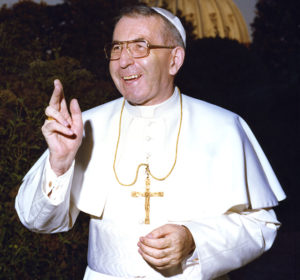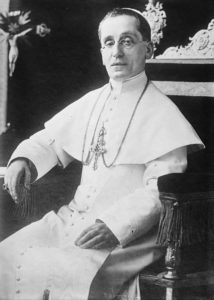Dear Parishioners,
How good it is to be able, once more, to send you the Newsletter and also the Readings for Holy Mass this weekend, with the hope and wish that you and your loved ones remain well and safe.
This week I took advantage of our liturgical new year and resolutely broke a habit that has been almost life-long. I parted company with an invited guest into my various homes, a travelling companion as I journey from place to place, someone who has shared desk and table fellowship with me, and has, in short, been an intrinsic part of my daily life. The grand action of which I speak was to turn the radio off between the hours of 12 noon and 2.00 p.m. Yes, I gave Jeremy Vine the elbow ! From the beginning of my memory storing its catalogue of events and scenarios the radio has provided its own easy-listening soundtrack against which life’s journey has been played out. My various addresses have provided homes for numerous radios dotted around living and work spaces. Although often commented on with a light air, they are in truth all tuned into one station – BBC Radio 2. Someone did once mention that other stations are available ! However, I’ve never ventured from the mountain of satisfaction to explore such rumours. There was never the need to break free from the long-held, and endanger wonderful memories of childhood played out against familiar voices and a pleasing choice of music. In my pre-school days Mum and I listened to Radio 1, but as disciples of Jimmy Young, we switched along with him to Radio 2 in 1973, and that is where the dial has remained ever since. Its programmes remain true to Lord John Reith’s mission statement that they should inform, educate and entertain. A giant of a man, he stood at six feet six inches, even taller than my former broadcasting companion, Mr. Vine.
My decision to separate from Jeremy Vine was an informed one, and came in response to the growing number of whingers, moaners and darn-right negative individuals that populate the window of opportunity he affords to listeners airing their views on news items and current affairs. Having been informed and educated by worthy and appropriate guests, not even entertainment could generously describe the views and opinions of some of those phoning-in. So, even imbued with a decent level of patience, this listener switched-off. Negativity rarely travels alone, it usually arrives with its off-spring, corrosion and destruction who, once sat at table, will soon devour any optimism and goodwill set before them.
Life experience over the larger part of 2020 has been difficult for many, and for significant numbers very tough indeed. It has thrown up many challenges and also a produced a huge number of shining stars, if not heroes. In the face of challenge I’ve heard many comments about the things that people have been unable to do or experience, in short called upon to sacrifice. Within most of us is the potential draft of such a list, more than likely quite a lengthy one, and compiled with relative ease. The harder path to pursue is to see the challenge and ask the question: what can be done about it. The words of John Fitzgerald Kennedy’s Inaugural Address as President of the United States of America come to mind: “Ask not what your country can do for you – ask what you can do for your country.” In the face of adversity, and words of despairing negativity, I have often had to reassure people that even with limitations and restrictions things are possible and can become a reality through extra effort, creativity and openness. Hence even with limited numbers, doors closed, and an inability to be tactile within the context of celebrating Sacraments, as a community we have celebrated arrivals, departures and unions amongst ourselves. I can assure you that at no time in my seven years of training did anyone give us instruction on how to conduct a meaningful Funeral in ten minutes or to use cotton buds safely during the anointing of a wriggling infant with the Holy Oils on the day of their Baptism, let alone how to stage-whisper the sacred vows of Marriage through a three-ply facial covering. Like many of my colleagues, who were able to continue to minister in Lockdown, I simply got on with it, learning all the while, and at times rehearsing many times over, in order to get the balance right, and not lose the precious significance of a moment that could not be replayed.
With the celebration of Christmas drawing ever closer there are many disparaging voices, announcing their discontentment loudly, pointing out what we are not going to be able to do or have: limited numbers around a table, no public houses in which to gather, overcrowded transport networks as everyone gravitates towards family homes at the same time, the inability to purchase or exchange gifts … to name but a few of the comments that have reached my ears. Having heard a colleague preaching along similar lines in Ireland recently, he drew his reflections to an end by saying: “Imagine if all that was left of our Christmas was the birth of Christ !”
The laments voiced today had their comparisons almost two thousand years ago. The road to Bethlehem was overcrowded as those of “David’s house and line” journeyed “in order to be registered.” The public houses were open, but so crowded that as “there was no room for them [Joseph and Mary] in the living space” the newly arrived Christ-child was “laid in manger.” No mention is made of a table. The only image of feeding in that stable scene is “a breastful of milk” described by Christina Rossetti in the carol “In the bleak midwinter.” As to any form of gifts, Sacred Scripture tells us that the shepherds “hurried away and found Mary and Joseph, and the baby lying in the manger,” in response to the angelic message they had received, but it makes no reference to them taking any presents along. Even in the visit of the gift-bearing Magi as told by St. Matthew, there is a very large clue that the presents of gold, frankincense and myrrh arrived quite some time after the first Christmas, perhaps up to two years judging by the age of the innocents slaughtered as a result of Herod’s insecurity.
Perhaps if all we have to celebrate this Christmas is the birth of Christ, the impact of that event will be more profound than usual. Christmas after Christmas the invitation is made to worshippers in our crowded churches to spend a moment of contemplation in front of the rather rarified crib-scene. In anticipation of present-opening and the veritable banquet that awaits extended family units hasty retreats are made, with a promise to do it next time.
Amid the characters populating the Christmas scene are those who are often overlooked, even mocked or criticized. Let us be more positive about them. The Innkeeper, who despite having a full house, had the compassion necessary to offer what little was spare – an outbuilding or cave, warmed by the body heat of its animal residents. The Shepherds who heard “news of great joy” and responded by going in search of “Christ the Lord,” displayed a generous trust in providence, believing that all would be well with that on which their livelihoods depended – their own sheep. And the Magi who never gave up on the hope afforded them by the “star they had seen rising” and which went ahead of them until it “halted over the place where the child was.” Beneath ever altering skies they journeyed on, sometimes with light step, sometimes trudging.
Earlier I mentioned shining stars and heroes that our time of adversity has produced. Some maybe almost household names like Captain Sir Tom Moore or Marcus Rashford, but in our midst have shone many who have reached out to others in tremendous acts of compassion, forged dependable friendships out of the limited materials of nodding acquaintance. Those who care for others through life-choice, not just the sick, elderly and vulnerable, but also the staff in our schools, who have done so much to provide new forms of education to the children of others. Not to mention the pastoral care that comes from seeing need and addressing it. These are the people within our community and society who are called upon to take risks, and in their rising to the challenge bear contemporary witness to the providential confidence of St. Luke’s shepherds. Others trudge onward, like the Magi. For them 2020 has brought untold heartache, uncertainty and darker skies than they’ve ever known, despite which they still seek the star to guide them. They journey on with a “hope that is not deceptive” (Romans 5:5).
Listening to the negative, whether it is the voice of stranger on the radio, or even someone who lives beneath the same roof as ourselves, being dismayed by the critical and guided by those without hope is not the recipe for the feast that we are journeying toward through these days of Advent. Such counsel places us in danger of letting Gospel good news slip through our fingers, replaced by a self-centred indulgence. If all we have on December 25th is the opportunity of celebrating the birth of Christ perhaps our celebration will be more authentic, honest and contain an integrity lost in years past by the “fripperies” poetically spoken of in a John Betjeman classic. The arrival of the Babe of Bethlehem as told by the authors of Sacred Scripture revealed the unimaginable love that God has for each and everyone of us, delivered amid the obscurity and randomness of history.
Pausing to reflect on that gift this year may we discover the contagion of that priceless love. Desiring to share it will bring joy in reaching out to others. In the effort made and the opportunity embraced our redemptive history will achieve its aim and goal. It will also find us displaying the gifts of those seemingly peripheral unnamed characters of the early pages of our Second Testament; the Innkeeper, shepherds and Magi – compassion, trust and hope. As Muhammad Ali once said: “Service to others is the rent you pay for your room on earth.” Whatever our address – stable, palace or any and all postcodes in between – may our homes be places of optimism, hope and joy this Advent and Christmas.
And if you’re wondering what or who has replaced Jeremy Vine ! I have dug out, dusted down and charged up a decade old Walkman, filled with music, songs and humour, personally chosen, which makes the world I populate feel an okay place, and one with a fabulous and glorious future ahead of it ! So perhaps the voices of the BBC Radio 2 listeners described earlier as whingers, moaners and negative individuals, have actually done me a good turn after all.
May we continue to remain faithful to each other through prayer and affection, united in the great hope that one day we shall be united again in the houses of God familiar to us.
As ever, Fr. Nicholas
 Hanukkah celebrates the defeat of the occupying Greek forces by Judas Maccabees, and the reclamation of the great Temple in Jerusalem for the worship of Almighty God by his chosen people. Seeking to acknowledge the sacred nature of the Temple as the dwelling place of the Most High the first task of those who entered it was to light the Menorah. The symbolism and importance of which is akin to our Sanctuary Lamp. On their entry into the Temple they discovered just a single vessel containing olive oil that had not been sullied by secular use at the hands of the Greeks. Sadly such a limited supply was only enough to offer a single day’s light, not long enough for more oil to be prepared and ritually purified, allowing it to be suitable for use in the Temple. Day by day the Temple Attendants noticed that the oil was burning much more slowly than normal. In fact, the one day’s supply of oil lasted for the full eight days. Deemed miraculous, the festival of Hanukkah was instituted in the Jewish calendar.
Hanukkah celebrates the defeat of the occupying Greek forces by Judas Maccabees, and the reclamation of the great Temple in Jerusalem for the worship of Almighty God by his chosen people. Seeking to acknowledge the sacred nature of the Temple as the dwelling place of the Most High the first task of those who entered it was to light the Menorah. The symbolism and importance of which is akin to our Sanctuary Lamp. On their entry into the Temple they discovered just a single vessel containing olive oil that had not been sullied by secular use at the hands of the Greeks. Sadly such a limited supply was only enough to offer a single day’s light, not long enough for more oil to be prepared and ritually purified, allowing it to be suitable for use in the Temple. Day by day the Temple Attendants noticed that the oil was burning much more slowly than normal. In fact, the one day’s supply of oil lasted for the full eight days. Deemed miraculous, the festival of Hanukkah was instituted in the Jewish calendar.

 The other member of my papal triumvirate is Pope Benedict XV, “The Unknown Pope.”Aged just 59 at his election in the early days of the Great War, following the demise – from a broken heart, it is said, caused by the war – of Pope St. Pius X, Benedict XV, was a relative youngster in comparison to many of his predecessors. Chosen, through the guidance of the Holy Spirit, for his diplomatic skills and prowess when the world dwelt under very dark skies, he had only been a Cardinal for three months before his election in early September-1914. Within just a few short weeks he had embarked on a personal mission to bring a lasting peace to a broken world. With the initial hopes of an end to hostilities by Christmas fast fading he called for a Christmas Truce. Whilst political leaders acknowledged the goodwill behind the call, they failed to back the initiative. At grass-roots level the voice of the Pope was heard, and during the week leading up to Christmas reports were made of British, French and German soldiers acknowledging the Season by crossing, in peace, into the no-man’s land that separated them. There are varying accounts of what the ordinary soldiers actually did with some reports of an exchange of greetings and small gifts, others of carol singing or football matches, whilst others speak of soldiers on opposing sides combining forces and resources to bury fallen comrades with dignity and appropriate ceremony, and others recording the handing back of prisoners of war. It was sporadic, but significant enough for it to make headline news. Truces in successive years were not nearly as many due to the determined opposition to them by military leaders, and even amongst the ranks of ordinary soldiers a hardness of heart, borne from the daily grind of war, ended most acts of festive goodwill.
The other member of my papal triumvirate is Pope Benedict XV, “The Unknown Pope.”Aged just 59 at his election in the early days of the Great War, following the demise – from a broken heart, it is said, caused by the war – of Pope St. Pius X, Benedict XV, was a relative youngster in comparison to many of his predecessors. Chosen, through the guidance of the Holy Spirit, for his diplomatic skills and prowess when the world dwelt under very dark skies, he had only been a Cardinal for three months before his election in early September-1914. Within just a few short weeks he had embarked on a personal mission to bring a lasting peace to a broken world. With the initial hopes of an end to hostilities by Christmas fast fading he called for a Christmas Truce. Whilst political leaders acknowledged the goodwill behind the call, they failed to back the initiative. At grass-roots level the voice of the Pope was heard, and during the week leading up to Christmas reports were made of British, French and German soldiers acknowledging the Season by crossing, in peace, into the no-man’s land that separated them. There are varying accounts of what the ordinary soldiers actually did with some reports of an exchange of greetings and small gifts, others of carol singing or football matches, whilst others speak of soldiers on opposing sides combining forces and resources to bury fallen comrades with dignity and appropriate ceremony, and others recording the handing back of prisoners of war. It was sporadic, but significant enough for it to make headline news. Truces in successive years were not nearly as many due to the determined opposition to them by military leaders, and even amongst the ranks of ordinary soldiers a hardness of heart, borne from the daily grind of war, ended most acts of festive goodwill.